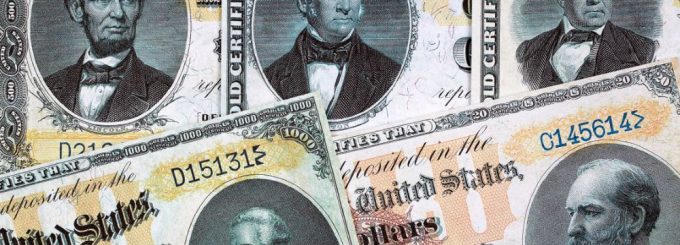An Overview of The 1882 Gold Certificate

During the 19th century, gold certificates were quite popular in the United States, especially when the nation’s economy used the gold standard. The certificates represented a specific amount of gold and could be redeemed for it at designated locations, which was much more safe and convenient than carrying around gold bars or coins. Though the U.S. is no longer on a gold standard and most of these certificates no longer exist, the few that do and are still in good condition can fetch fabulous prices, especially the 1882 gold certificate.
Currency Highlights
This high denomination currency features an image of Alexander Hamilton, who was America’s very first Treasury Secretary. He served in this capacity from 1789 until 1795, and was in favor of a gold standard which was monometallic. However in reality he ultimately decided to authorize a bimetallic currency system where a fixed ratio existed between gold and silver at 15:1. He was honored by appearing on a gold certificate nearly 100 years later, which is the 1882 $1000 Very Fine 30 Golden Certificate PMG, which is quite possibly one of the rarest notes in the United States, that is sought after by hardcore collectors with deep pockets.
Just how rare and expensive is this certificate? A single one has been auctioned off for almost $375,000, which is more than many American single family homes. The demand for this note is extraordinary, and it is believed by experts that the total number now in circulation is approximately five. However, three of them are not available to the public, since one is possessed by the San Francisco Federal Reserve while the rest are in private hands.
Background
Alexander Hamilton was one of the founding fathers of the United States and took part in the Revolutionary War. He was also a Federalist Party founder and played a key role in the nation’s early fiscal system. His other accomplishments include the establishment of the United States Coast Guard as well as the newspaper New York Post. Politically, he believed in a robust central government controlled by a stringent executive branch, with a prosperous commercial economy and a strong manufacturing base with formidable national defense. Despite his humble beginnings as an orphan, he had the good fortune of being cared for by wealthy merchants and local patrons who recognized his talents and saw to his education.
Aside from the $1000 denomination, there are others. These include the 1934 $5,000 Fr. 2221-G note, which can fetch up to $200,000 or more. One of the most high profile collectors of these rare notes is Ibrahim Salem, considered by many to be the world’s premiere banknote collector. He has searched for rare notes both in the United States and other countries, especially notes that display serial numbers which are rare. $5,000 FRN attrition rates tended to be considerably higher than $10,000 FRNs, partly due to preservation of many specimens from the infamous Binion hoard. Some excellent $5,000 FRN notes have been found which have consecutive serial numbers with excellent condition and eye appeal.


